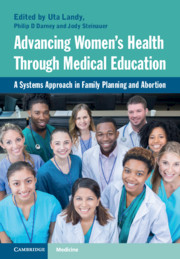 Advancing Women's Health Through Medical Education
Advancing Women's Health Through Medical Education from Section IV - Reproductive Health Services & Abortion Training: Global Examples
Published online by Cambridge University Press: 30 July 2021
Abortion is legal in Uruguay since 2012. It was preceded by the implementation of a model of risk reduction from unsafe abortion which, based on the values of medical professionalism, laid the foundation for the legal change. To respond to these changes, there is a need to train doctors and residents in gynecology and obstetrics in Sexual and Reproductive Health, both in medical aspects and attitudes, as well as in the current regulatory framework. The development of a university curriculum in Sexual and Reproductive Health (SRH), and the results of its implementation are presented.
To save this book to your Kindle, first ensure no-reply@cambridge.org is added to your Approved Personal Document E-mail List under your Personal Document Settings on the Manage Your Content and Devices page of your Amazon account. Then enter the ‘name’ part of your Kindle email address below. Find out more about saving to your Kindle.
Note you can select to save to either the @free.kindle.com or @kindle.com variations. ‘@free.kindle.com’ emails are free but can only be saved to your device when it is connected to wi-fi. ‘@kindle.com’ emails can be delivered even when you are not connected to wi-fi, but note that service fees apply.
Find out more about the Kindle Personal Document Service.
To save content items to your account, please confirm that you agree to abide by our usage policies. If this is the first time you use this feature, you will be asked to authorise Cambridge Core to connect with your account. Find out more about saving content to Dropbox.
To save content items to your account, please confirm that you agree to abide by our usage policies. If this is the first time you use this feature, you will be asked to authorise Cambridge Core to connect with your account. Find out more about saving content to Google Drive.